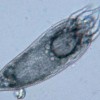 Phyllocoptes fructiphilus Keifer, a tiny eriophyid mite, is the vector of a devastating viral disease of roses called Rose Rosette Disease (RRD). This mite can be spread by the wind and by contaminated clothing and equipment. It also is possible that it can disperse through phoresy (attaching itself to insects). As a result, the distribution of the mite and RRD is expanding. This 5-page fact sheet was written by Marjorie Hoy, and published by the UF Department of Entomology and Nematology, May 2013.
Phyllocoptes fructiphilus Keifer, a tiny eriophyid mite, is the vector of a devastating viral disease of roses called Rose Rosette Disease (RRD). This mite can be spread by the wind and by contaminated clothing and equipment. It also is possible that it can disperse through phoresy (attaching itself to insects). As a result, the distribution of the mite and RRD is expanding. This 5-page fact sheet was written by Marjorie Hoy, and published by the UF Department of Entomology and Nematology, May 2013.
http://edis.ifas.ufl.edu/in999
Tag: Rose Pest Management
Rose Pests and Diseases in Florida (ENH1108/EP371)
 Roses are one of the most popular flowering shrubs in Florida and the United States. Valued for their beautiful and often fragrant blooms, roses have been cultivated in gardens for centuries as vines. Roses can grow and flower 9 months of the year in North Florida and year-round in the rest of Florida. Roses have become especially popular in recent years with the introduction of Knock Out® and other shrub roses. Unfortunately, increased use and misuse of roses have resulted in more reports of pest problems. This 9-page fact sheet was written by Gary W. Knox, Mathews Paret, and Russell F. Mizell, III, and published by the UF Department of Environmental Horticulture, January 2012.
Roses are one of the most popular flowering shrubs in Florida and the United States. Valued for their beautiful and often fragrant blooms, roses have been cultivated in gardens for centuries as vines. Roses can grow and flower 9 months of the year in North Florida and year-round in the rest of Florida. Roses have become especially popular in recent years with the introduction of Knock Out® and other shrub roses. Unfortunately, increased use and misuse of roses have resulted in more reports of pest problems. This 9-page fact sheet was written by Gary W. Knox, Mathews Paret, and Russell F. Mizell, III, and published by the UF Department of Environmental Horticulture, January 2012.
http://edis.ifas.ufl.edu/ep371
EENY375/IN678 Fuller Rose Beetle, Naupactus godmanni (Crotch) (Insecta:Coleoptera: Curculionidae)
Revised! EENY-375, a 5-page illustrated fact sheet by Jamba Gyeltshen and Amanda Hodges, is part of the Featured Creatures collection. It describes this cosmopolitan beetle whose extensive list of hosts include citrus, cucurbits, strawberry, beans, peach, rhubarb, rose, and potato — synonymy, distribution, description, biology, host plants, damage, and management. Includes references. Published by the UF Department of Entomology and Nematology, June 2009.
http://edis.ifas.ufl.edu/IN678
PP268 Black Spot of Rose
PP268, a 5-page illustrated fact sheet by Jozer Mangandi and Natalia A. Peres, describes this fungal disease that that affects nearly all rose cultivars worldwide — causal agent and geographic distribution, symptoms and control. Published by the UF Department of Plant Pathology, May 2009.
http://edis.ifas.ufl.edu/PP268
PP267 Cercospora Leaf Spot of Rose
PP267, a 4-page illustrated fact sheet by Jozer Mangandi and Natalia A. Peres, describes this little-investigated disease that is one of the primary foliar diseases of roses in Florida — causal agent and geographic distribution, symptoms and control. Published by the UF Department of Plant Pathology, May 2009.
http://edis.ifas.ufl.edu/PP267
ENH1108/EP371 Pests of Roses in Florida
ENH-1108, a 7-page illustrated fact sheet by Gary W. Knox and Russell F. Mizell, III, provides basic information for homeowners on minimizing rose pests through selection and care, describes major pests of roses, as well as other diseases, insect, mites, arthropods, and animals that are pests of roses. Includes references. Published by the UF Department of Environmental Horticulture, December 2008.
http://edis.ifas.ufl.edu/EP371